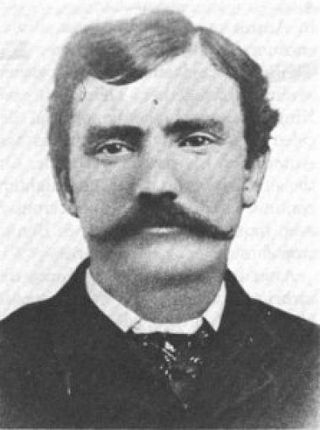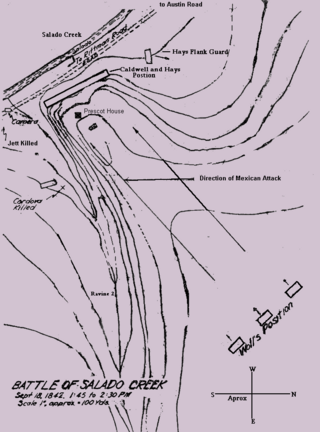
The Battle of Palmito Ranch, also known as the Battle of Palmito Hill, is considered by some criteria the final battle of the American Civil War. It was fought May 12 and 13, 1865, on the banks of the Rio Grande east of Brownsville, Texas, and a few miles from the seaport of Los Brazos de Santiago, at the southern tip of Texas. The battle took place more than a month after the surrender of the Army of Northern Virginia under Robert E. Lee to Union forces at Appomattox Court House, which had since been communicated to both commanders at Palmito. However, in early May Confederate General Edmund Kirby Smith had rejected a proposal from Union Major-General John Pope to surrender Confederate forces in the Trans-Mississippi Department on the same terms that General Ulysses S. Grant had given to Robert E. Lee. As such Kirby-Smith only officially surrendered all Confederate forces in the Trans-Mississippi Department on June 2, 1865.

Juan Nepomuceno Cortina Goseacochea, also known by his nicknames Cheno Cortina, the Red Robber of the Rio Grande and the Rio Grande Robin Hood, was a Mexican rancher, politician, military leader, outlaw and folk hero. He was an important caudillo, military general and regional leader, who effectively controlled the Mexican state of Tamaulipas as governor. In borderlands history he is known for leading a paramilitary mounted Mexican Militia in the failed Cortina Wars. The "Wars" were raids targeting Anglo-American civilians whose settlement Cortina opposed near the several leagues of land granted to his wealthy family on both sides of the Rio Grande. Anglo families began immigrating to the Lower Rio Grande Valley after the Mexican Army was defeated by the Anglo-Mexican rebels of the Mexican State of Tejas, in the Texas Revolution.

The Cortina Troubles is the generic name for the First Cortina War, from 1859 to 1860, and the Second Cortina War, in 1861, in which paramilitary forces led by the Mexican rancher and local leader Juan Cortina, confronted elements of the United States Army, the Confederate States Army, the Texas Rangers, and the local militias of Brownsville, Texas, and Matamoros, Tamaulipas.

John Salmon Ford, better known as "Rip" Ford, was a member of the Republic of Texas Congress and the Texas Senate. He was also the mayor of Brownsville and Austin. Ford was a Texas Ranger, a Confederate colonel, a doctor, a lawyer, and a journalist and newspaper owner. He commanded men during the Antelope Hills expedition and later led the Confederate forces in what was arguably the last engagement of the American Civil War, the Battle of Palmito Ranch on May 12–13, 1865. It was a Confederate victory, but as it occurred more than a month after Robert E. Lee's surrender, it did not affect the war's outcome.

Samuel Peter Heintzelman was a United States Army general. He served in the Seminole War, the Mexican–American War, the Yuma War and the Cortina Troubles. During the American Civil War he was a prominent figure in the early months of the war rising to the command of a corps.

Leander Harvey McNelly was a Confederate officer and Texas Ranger captain. McNelly is best remembered for leading the "Special Force", a quasi-military branch of the Texas Rangers that operated in south Texas in 1875–76.

John King Fisher was a gunslinger and vigilante from the U.S. state of Texas during the heyday of the American Old West.

The Las Cuevas War was a brief armed conflict fought mainly between a force of Texas Rangers, commanded by Captain Leander McNelly, and an irregular force of Mexican bandits. It took place in November 1875, in and around Las Cuevas, Tamaulipas. The Texans crossed the Rio Grande into Mexican territory with the purpose of returning stolen cattle to the American side of the river but they were drawn into a battle with local militia forces. When the fighting was over the Mexicans returned the cattle to the Texans.

Juan Alamia was an American soldier who served as a Rough Rider in the Spanish–American War.

The 13th Maine Infantry Regiment was an infantry regiment that served in the Union Army during the American Civil War. The regiment spent 1862–1864 in the Department of the Gulf and finished the war with the Army of the Shenandoah. During its service, it survived a hurricane off the Carolinas en route the Gulf of Mexico, manned the forts guarding the Mississippi Delta, invaded Texas at the Rio Grande and along the coast, fought in Banks' ill-fated Red River Campaign in Louisiana, manned Washington, D.C., defenses, and provided rear-area security for the Shenandoah Valley campaign in 1864 south of Harpers Ferry.

The Plan of San Diego was a plan drafted in San Diego, Texas, in 1915 by a group of unidentified Mexican and Tejano rebels who hoped to seize Arizona, New Mexico, California, and Texas from the United States. The plan was never attempted. It called for a general uprising in February, 1915, and the mass killings of every non-Hispanic Caucasian male over 16 years of age. The arena included all of South Texas. German Americans were excluded from the killings. The San Diego Plan collapsed immediately on discovery.

The Yuma War was the name given to a series of United States military operations conducted in Southern California and what is today southwestern Arizona from 1850 to 1853. The Quechan were the primary opponent of the United States Army, though engagements were fought between the Americans and other native groups in the region.

The Battle of the Salado was a decisive engagement in 1842 which repulsed the final Mexican invasion of the Republic of Texas. Colonel Mathew Caldwell of the Texas Rangers led just over 200 militia against an army of 1,600 Mexican Army soldiers and Cherokee warriors, and defeated them outside of San Antonio de Bexar along Salado Creek. As a result of this action, French-Mexican commander General Adrián Woll retreated south and back into Mexico.
The Raid on the Norias Division of the King Ranch was an attack August 8, 1915 by a large band of disaffected Mexicans and Tejanos in southern Texas. It was one of the many small battles of the Mexican Revolution that spilled over into United States soil and resulted in an increased effort by the United States Army to defend the international border. Five to fifteen attackers were killed in the raid and more among the wounded may have died shortly afterwards.
The Bandit War, or Bandit Wars, was a series of raids in Texas that started in 1915 and finally culminated in 1919. They were carried out by Mexican rebels from the states of Tamaulipas, Coahuila, and Chihuahua. Prior to 1914, the Carrancistas had been responsible for most attacks along the border, but in January 1915, rebels known as "Sedicionistas" drafted the Plan of San Diego and began launching their own raids. The plan called for a race war to rid the American border states of their Anglo-American population and for the annexation of the border states to Mexico. However, the "Sedicionistas" could never launch a full-scale invasion of the United States and so the faction resorted to conducting small raids into Texas. Much of the fighting involved the Texas Ranger Division, but the US Army also engaged in small unit actions with bands of Seditionist raiders.

The Brite Ranch raid was an incident that occurred on Christmas Day 1917, in which Mexican raiders crossed the Rio Grande River border and attacked a ranch in Presidio County, Texas. At the time the raiders were thought to be Villistas, as they had been responsible for several other previous incursions into American territory, though other accounts say that some Carrancistas were involved as well. During the raid the Mexicans murdered three people, robbed a general store and rode back to Chihuahua under pursuit by a motorized posse and troops of the United States Army 8th Cavalry. The Americans fought a running battle with the Mexicans on December 26 that resulted in the deaths of several raiders and the recovery of some stolen property. Soon after, an expedition to find more of the raiders led to another more violent episode when, on January 27, 1918, a force of Texas Rangers accompanied by US Cavalry, executed 15 Mexican men in what became known as the Porvenir Massacre.

The Battle of Rio Grande City was a military engagement during the Cortina War between pro-Mexican Cortinistas and a group of US Army regulars supported by Texas Rangers.
Adrián J. Vidal was a Mexican soldier who fought in both the American Civil War and the Mexican War against France in the 1860s. He served the Confederate States of America Army from October 1862 to 1863, when he and his troops defected. He was branded a traitor, having killed one Confederate soldier, wounded another, and killed as many as ten or more individuals. He was said to have planned an attack on Brownsville after defecting from the Confederate Army. In the end, General Hamilton P. Bee ordered that Fort Brown and Brownsville be set on fire, destroying large quantities of cotton and military goods under the watchful eyes of 400 Union troops as well as Juan Cortina and his soldiers on the opposite bank of the Rio Grande. The next month, he enlisted in the Union Army, serving just six months. During that time he captured an Army tugboat and its crew. He then fought under General Juan Cortina during the Second French intervention in Mexico. Vidal was captured by the French who executed him by a firing squad in June 1865.

Mifflin Kenedy (1818–1895) was a rancher, steamboat operator, and investor who settled in Texas. He began his steamboating career on the Ohio, Mississippi, and Missouri Rivers. He then went to Texas and northern Mexico, where he helped get many steamboats to the Rio Grande area during the First Cortina War (1859–1860). Using the Corvette, he transported General Zachary Taylor and his soldiers on the Rio Grande and then overland to Camargo, Mexico. He became successful during the Civil War when he transported goods along the Rio Grande. Kenedy operated ranches and invested in railroads in Texas, some of them in partnership with Richard King. He was among the first ranchers to fence in his ranches, starting with the 36-miles of fencing around Laureles Ranch. Kenedy was inducted into the Hall of Great Westerners.

The Brownsville Raid was the opening act of the Cortina Troubles, a series of raids by Mexican rancher Juan Cortina into Texas. The raid was precipitated by Brownsville sheriff Robert Shears attacking a Mexican man named Thomas Cabrera and in turn being shot by Cortina. The incident was a culmination of growing discontent between Mexicans and Texan settlers.
















